I love my cat dearly, but I’ve had my fair share of early morning wake-up calls from the sound of scratching at my bedroom door. If you’re dealing with the same issue, don’t worry, I’ve got you covered. In this article, I will share some tried and true techniques to help you stop your cat from scratching at the door in the morning.
Cats are known for their independent and sometimes stubborn nature, so punishment is not the answer here. Instead, we’ll focus on positive reinforcement and providing alternatives to redirect their attention. With a little patience and consistency, we can modify their behavior and enjoy peaceful mornings once again.
Key Takeaways:
- Understanding why cats scratch at doors in the morning is crucial for finding effective solutions.
- Creating a routine and providing alternatives, such as scratching posts, can help redirect their scratching behavior.
- Using deterrents like sticky tape or deterrent sprays can discourage cats from scratching at doors.
- Ensuring the environment is cat-friendly and providing mental and physical stimulation can reduce the desire to scratch.
- Positive reinforcement and consistency are key in training cats to stop scratching at doors in the morning.
Understanding the Behavior
When it comes to addressing a cat’s scratching behavior at doors in the morning, it’s important to first understand the reasons behind it. Cats naturally scratch for various purposes, including marking territory, stretching, and maintaining healthy claws. In the case of scratching at doors, it may be a sign of boredom or a desire for social interaction.
To effectively modify this behavior, it’s essential to provide cats with environmental enrichment and mental stimulation. This can help alleviate their need for attention-seeking behaviors like scratching at doors. Engaging in interactive playtime and offering a variety of toys can keep cats mentally and physically stimulated, reducing the desire to scratch.
Understanding the underlying reasons for a cat’s behavior is crucial in finding effective solutions.”
In addition to providing enrichment, it’s important to consider the cat’s overall well-being. Ensuring they have a safe and comfortable environment with appropriate scratching surfaces, such as vertical and horizontal scratching posts, can redirect their behavior away from doors. By addressing their natural instincts and needs, we can discourage scratching at doors in the morning and promote a healthier relationship with our feline friends.

| Common Reasons for Door Scratching | How to Address Them |
|---|---|
| Lack of mental stimulation | Provide interactive toys and engage in playtime |
| Desire for social interaction | Allocate dedicated playtime and provide companionship |
| Boredom | Rotate toys and offer a variety of play options |
| Marking territory | Provide appropriate scratching surfaces |
| Stretching | Encourage exercise and provide access to scratching posts |
Understanding a cat’s behavior and addressing their needs are fundamental in preventing door scratching. By implementing strategies that focus on providing enrichment, redirecting their behavior, and ensuring their overall well-being, we can successfully modify this unwanted behavior. Consistency and patience are key, as it takes time and effort to create new habits. With understanding and the right approach, we can enjoy peaceful mornings without the sound of scratching at doors.
Creating a Routine and Providing Alternatives
When it comes to discouraging cats from scratching doors in the morning, establishing a routine and providing alternatives are key strategies. By implementing a consistent schedule and offering enticing alternatives, you can redirect your cat’s attention and minimize their desire to scratch at doors.
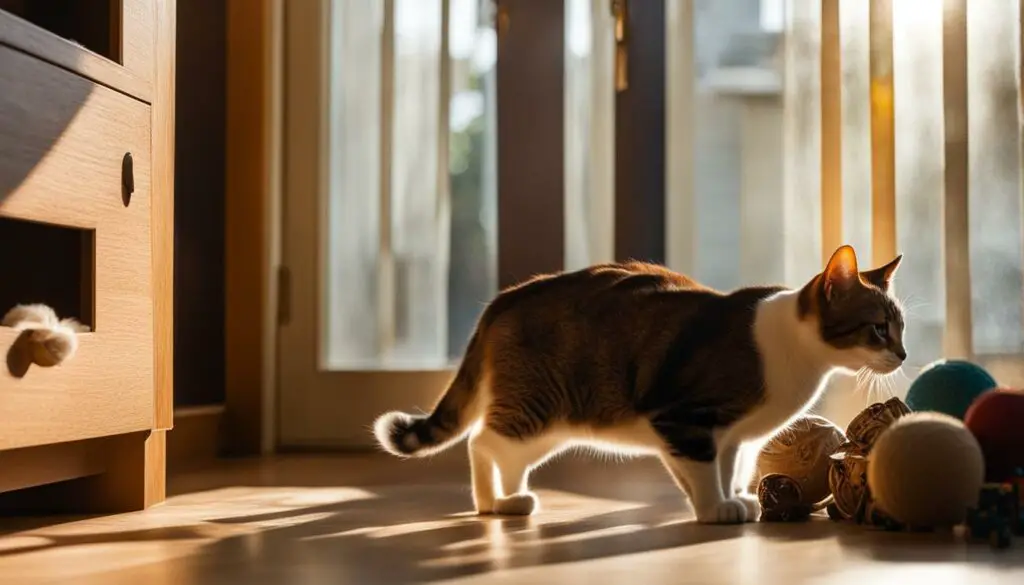
One effective approach is to establish a routine that includes interactive playtime and feeding before bedtime. By engaging your cat in vigorous play sessions and providing a satisfying meal, you can help tire them out and promote relaxation during the night. A tired cat is less likely to engage in attention-seeking behaviors, such as scratching at doors, in the morning.
Additionally, providing your cat with suitable scratching posts and boards in strategic locations can redirect their scratching behavior away from doors. Cats have a natural urge to scratch to mark their territory and maintain their claws. By offering designated scratching surfaces, you provide them with an appropriate outlet for this behavior. Be sure to choose scratching materials that your cat enjoys, such as sisal rope or corrugated cardboard.
Creating a Routine and Providing Alternatives
| Tip | Description |
|---|---|
| Establish a bedtime routine | Schedule interactive playtime and feeding before bedtime to tire out your cat and promote relaxation during the night. |
| Provide suitable scratching surfaces | Offer scratching posts and boards in strategic locations to redirect your cat’s scratching behavior away from doors. |
| Engage in interactive play | Play with your cat using toys and engage in interactive play sessions to keep them mentally and physically stimulated. |
Incorporating a variety of toys and engaging in interactive play sessions throughout the day can also help keep your cat mentally and physically stimulated. This can reduce their desire to engage in destructive behaviors, such as scratching at doors, as they have other outlets for their energy and natural instincts.
By creating a routine, providing alternatives, and ensuring your cat’s needs are met, you can effectively discourage them from scratching at doors in the morning. Remember to be patient and consistent in your approach, as changing behavior takes time. With these strategies in place, you can enjoy peaceful mornings free from door scratching.
Using Deterrents and Negative Associations
When it comes to stopping cats from scratching at doors in the morning, using deterrents and negative associations can be effective methods. By creating negative experiences when scratching occurs, cats can learn to associate the behavior with unpleasant consequences. Here are some techniques to consider:
- Deterrent sprays: Applying deterrent sprays on the doors can create an unpleasant smell or taste that cats dislike. This can discourage them from scratching the surface.
- Sticky tape: Placing sticky tape on the door can deter cats from scratching because they don’t like the texture sticking to their paws.
- Aluminum foil: Cats generally dislike the sound and sensation of scratching on aluminum foil. Covering the door with foil can deter them from scratching in the morning.
It’s important to introduce these deterrents consistently and remove them once the behavior is discouraged. Providing suitable alternatives and positive reinforcement for desired behavior is crucial in the training process. Remember, patience and persistence are key when trying to modify a cat’s behavior.
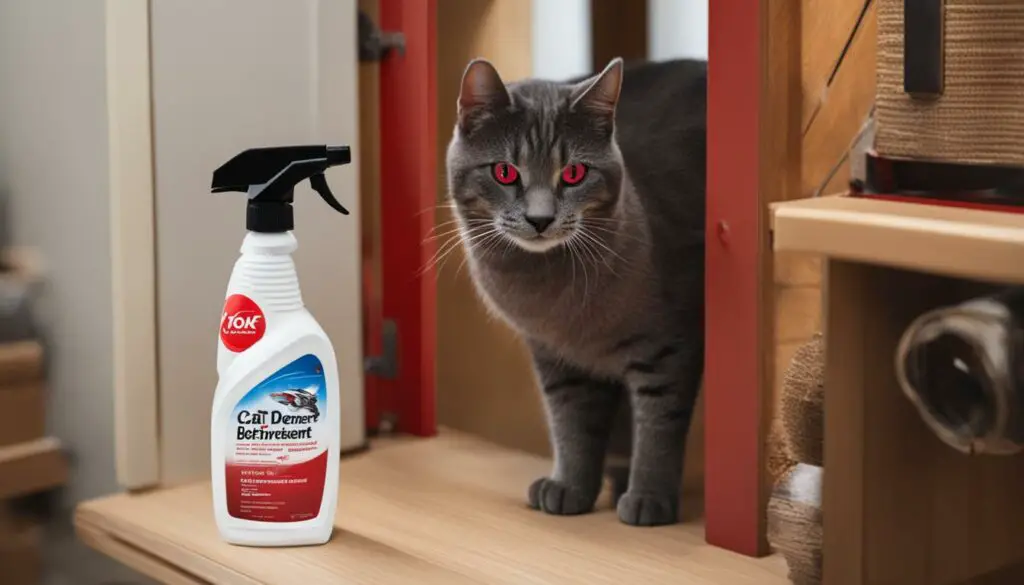
This image showcases a cat using a scratching post, which can be a great alternative to scratching at doors.
Tips to Prevent Cat Scratching at Doors: Ways to Discourage Cats from Scratching Doors
If you’re looking for effective ways to prevent your cat from scratching at doors, here are some valuable tips to keep in mind. Cats can develop this behavior for various reasons, including seeking attention or access to certain areas. By understanding their needs and providing appropriate alternatives, you can discourage this unwanted behavior and maintain a scratch-free environment.
1. Provide Ample Scratching Surfaces: Cats have a natural instinct to scratch, so it’s important to provide them with suitable alternatives. Place scratching posts or boards in strategic locations, such as near the doors they tend to scratch. These surfaces should be sturdy and tall enough for your cat to fully stretch and scratch comfortably.
2. Use Deterrents: To discourage scratching at doors, you can use deterrents that cats find unpleasant. Apply double-sided sticky tape or aluminum foil on the targeted areas. You can also use odor deterrent sprays specifically designed for this purpose. These methods create an association between scratching and negative experiences, gradually deterring your cat from engaging in this behavior.
3. Provide Environmental Enrichment: Boredom can often lead cats to scratch doors in search of stimulation. Make sure to provide plenty of environmental enrichment to keep your cat mentally and physically engaged. Interactive toys, puzzle feeders, and play sessions can help alleviate boredom and reduce the desire to scratch at doors.

4. Maintain a Consistent Routine: Establishing a consistent routine can help manage your cat’s behavior. Schedule interactive playtime and feeding sessions before bedtime to tire out your cat and promote relaxation during the night. Implementing a routine can help prevent your cat from becoming restless and scratching at doors in the morning.
By following these tips, you can create a cat-friendly environment and effectively discourage your cat from scratching at doors. Remember to be patient and consistent in your approach, and always provide positive reinforcement for desired behaviors. With time and understanding, you can help your cat break the habit of scratching at doors and enjoy a peaceful living space.
Consistency and Persistence
In order to effectively prevent cats from scratching at doors, consistency and persistence in implementing deterrents and providing alternative options are key. Changing a cat’s behavior takes time and patience, so it is important to remain dedicated to the process.
Consistency should be maintained in using the chosen deterrents, such as sticky tape, deterrent sprays, or aluminum foil on the doors. These measures create a negative association with scratching and discourage the behavior. It is important to consistently apply these deterrents and remove them once the cat has learned to avoid scratching at the doors.
Persistence is also crucial in providing suitable alternatives for cats to scratch. By offering a variety of scratching posts and boards in strategic locations, cats can redirect their scratching behavior away from the doors. It may take time for cats to adopt these alternatives, so it is important to be persistent and patient in encouraging their use.
Reinforcing positive behavior is another aspect of consistency and persistence. Cats should be rewarded with praise, treats, or playtime when they use appropriate scratching surfaces instead of scratching at doors. This positive reinforcement helps to motivate cats to repeat the desired behavior and further discourages door scratching.
By maintaining consistency in the use of deterrents, providing suitable alternatives, and reinforcing positive behavior, cats can learn that scratching at doors is not acceptable. Consistency and persistence are vital in the process of behavior modification and the prevention of scratching at doors in the morning.
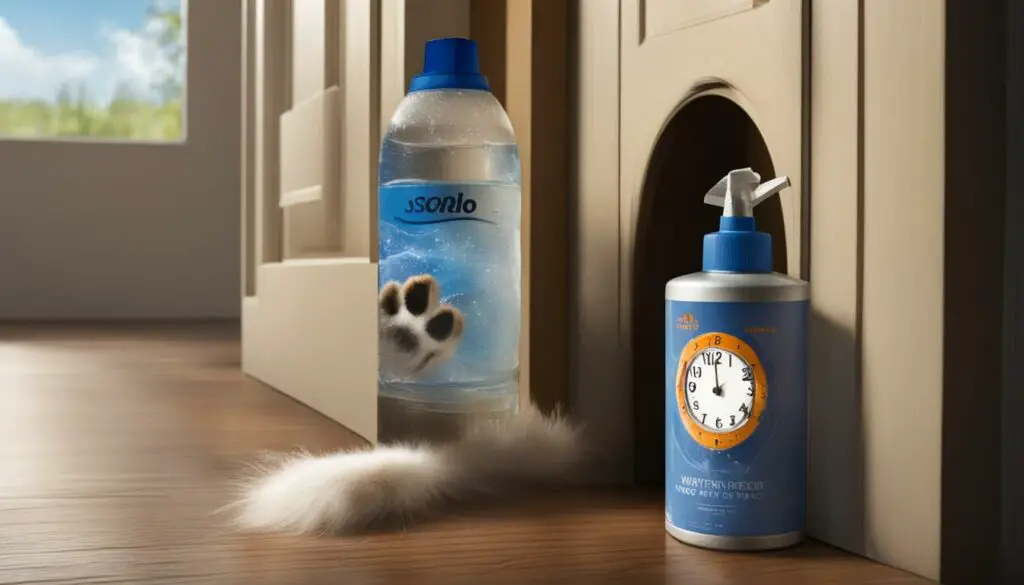
Table: Common Cat Scratching Deterrents
| Deterrent | Description |
|---|---|
| Sticky Tape | Stick strips of double-sided sticky tape on the lower part of the door to create an unpleasant texture for cats. |
| Deterrent Sprays | Use specially formulated sprays that have scents that cats dislike to discourage scratching at doors. |
| Aluminum Foil | Place sheets of aluminum foil on the doors, as cats generally dislike the sound and feel of scratching it. |
Quote: “Consistency and persistence are key in changing a cat’s behavior and preventing door scratching. By consistently using deterrents, providing alternatives, and reinforcing positive behavior, cats can learn to avoid scratching at doors.”
Cat Behavior Modification Techniques: Effective Methods to Stop Cat Scratching at Doors
Understanding and addressing cat scratching behavior requires patience, consistency, and the implementation of effective techniques. In this section, I will explore various cat behavior modification techniques that can help stop cats from scratching at doors in the morning.
Providing Environmental Enrichment
One effective approach is to provide environmental enrichment to keep cats mentally and physically stimulated. Interactive toys, puzzle feeders, and scratching posts are great options to engage cats and redirect their scratching behavior. By offering a variety of play options and rotating toys, you can prevent boredom and reduce the likelihood of scratching at doors in the morning.
Positive Reinforcement and Alternatives
Positive reinforcement plays a crucial role in training cats to stop scratching at doors. Rewarding desired behaviors, such as using appropriate scratching surfaces or engaging in playtime, can motivate cats to repeat those behaviors. Additionally, providing suitable alternatives, such as scratching posts and boards, redirect their scratching behavior away from doors.
Consistency and Professional Help
Consistency is key when it comes to modifying cat behavior. Implementing the chosen deterrents, providing alternatives, and reinforcing positive behavior should be done consistently to achieve the desired results. If the scratching behavior persists despite efforts, seeking guidance from a professional cat behaviorist or veterinarian is recommended. They can provide personalized advice and techniques based on the specific needs and behavior of the cat.
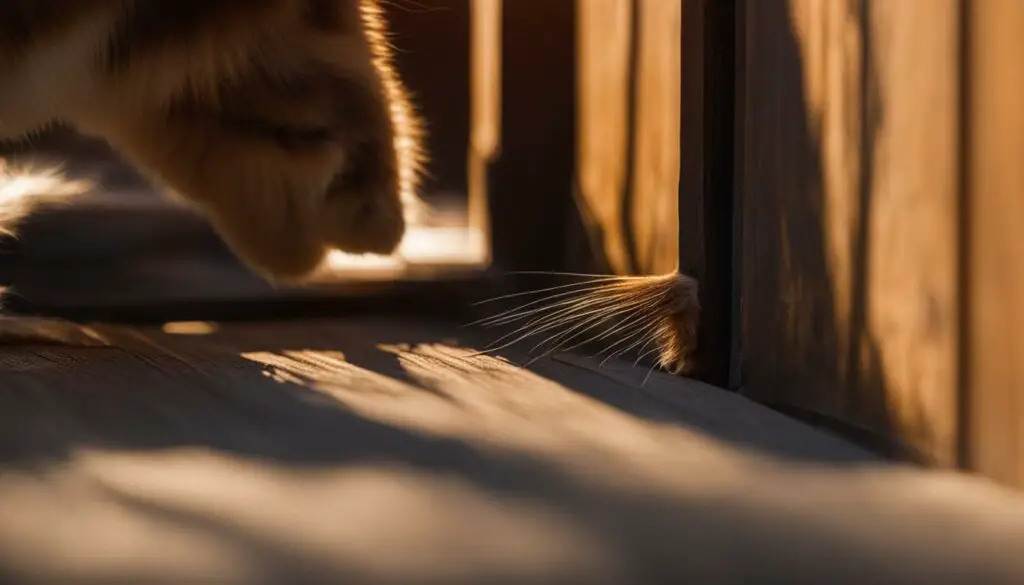
| Deterrents | Effectiveness | Usage |
|---|---|---|
| Sticky tape | Effective at creating a negative association | Apply to the door to deter scratching |
| Deterrent sprays | Can help deter scratching behavior | Apply to the door following the product instructions |
| Aluminum foil | Creates an unpleasant texture and sound | Place sheets of aluminum foil on the door surface |
By implementing these cat behavior modification techniques, owners can effectively stop cats from scratching at doors in the morning. Consistency, patience, and understanding are key in achieving the desired results. Remember to provide environmental enrichment, reinforce positive behavior, and seek professional help when needed.
Understanding Cat’s Natural Behavior
Cats are natural scratchers, and it’s important to understand and accept this behavior when trying to prevent them from scratching at doors in the morning. Scratching serves various purposes for cats, including marking territory, stretching their muscles, and maintaining healthy claws. By providing appropriate scratching surfaces and outlets for their natural behavior, you can redirect their scratching away from doors and prevent unwanted damage.
One effective solution is to offer a variety of scratching posts and boards throughout your home. Cats have preferences when it comes to scratching materials, so providing options like sisal, cardboard, or carpeted surfaces can help cater to their individual preferences. Placing the scratching posts near the doors they usually scratch can further encourage them to use the posts instead. It’s important to remember that cats scratch not only to maintain their claws but also to leave visible marks for other cats, signaling their presence and territory. By understanding and addressing their natural instincts, we can promote healthier scratching habits.
In addition to providing appropriate scratching surfaces, it’s crucial to create a stimulating environment for your cat. This can help redirect their attention and reduce the desire to scratch at doors. Interactive toys, puzzle feeders, and playtime sessions can keep cats mentally and physically engaged. Rotating toys and introducing new ones on a regular basis can prevent boredom and provide alternative ways for cats to release their energy, ultimately reducing their inclination to scratch at doors in the morning.
| Table: Tips for Preventing Door Scratching in Cats |
|---|
| Provide multiple scratching posts and boards throughout the house. |
| Offer a variety of scratching materials, such as sisal, cardboard, or carpet. |
| Place scratching posts near the doors cats typically scratch. |
| Rotate and introduce new toys to keep cats mentally and physically stimulated. |
| Engage in regular playtime sessions and use interactive toys. |
By understanding and addressing a cat’s natural behavior, providing appropriate scratching surfaces, and offering a stimulating environment, you can effectively prevent them from scratching at doors in the morning. Remember to be patient and consistent in your approach, using positive reinforcement to reward and encourage desired behaviors. With time and effort, you can create a harmonious living environment and enjoy peaceful mornings without the sound of scratching at the door.
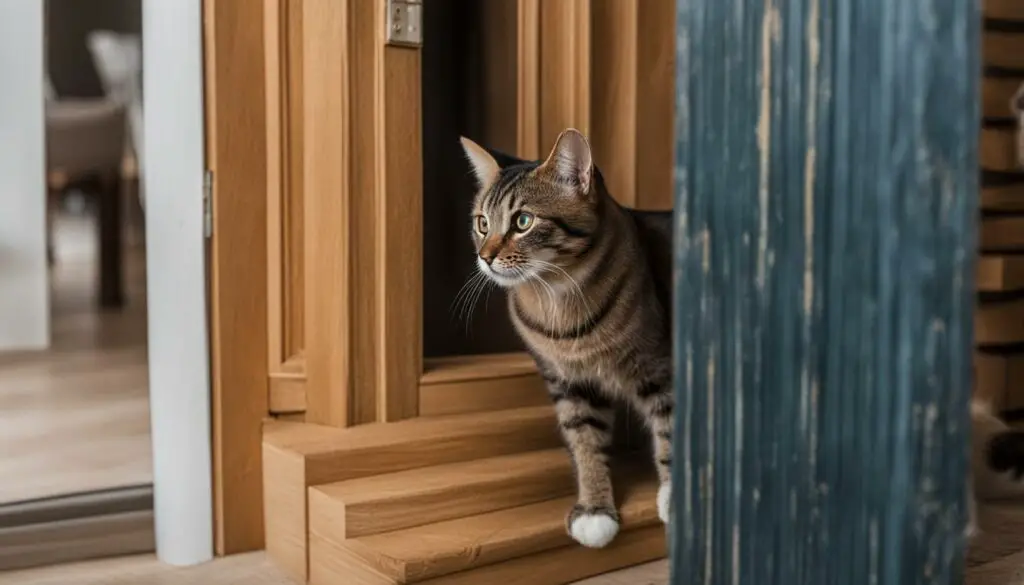
Environmental Enrichment
Preventing door scratching in cats can be achieved through providing environmental enrichment. Cats are intelligent and curious creatures that thrive on mental and physical stimulation. By offering them engaging and interactive activities, we can help divert their attention away from scratching at doors in the morning.
One effective way to enrich a cat’s environment is by providing interactive toys. These toys can stimulate their natural hunting instincts, keeping them engaged and entertained. Puzzle feeders are also a great option as they encourage cats to problem solve and work for their food, providing mental stimulation and reducing boredom.
“Environmental enrichment is crucial for the well-being of cats. By ensuring they have access to a variety of toys and activities, we can prevent unwanted behaviors like door scratching and promote a happy and healthy feline companion.”
– Dr. Emily Carter, Feline Behavior Specialist
In addition to toys, incorporating scratching posts and boards in different areas of the house can give cats an appropriate outlet for their scratching behavior. These surfaces should be sturdy, sisal or carpeted, and tall enough for cats to stretch and claw comfortably. By providing them with suitable alternatives, we can redirect their scratching instinct away from doors.
Table: Environmental Enrichment Techniques
| Technique | Description |
|---|---|
| Interactive Toys | Stimulate hunting instincts and provide mental stimulation. |
| Puzzle Feeders | Encourage problem-solving and keep cats engaged. |
| Scratching Posts | Provide appropriate outlets for scratching behavior. |
| Vertical Perches | Offer elevated spaces for cats to climb and observe their surroundings. |
| Hideaways | Create cozy spaces for cats to retreat and feel secure. |
By implementing these environmental enrichment techniques, we can create a stimulating and engaging environment for our cats. Remember, prevention is key when it comes to discouraging cats from scratching doors. Providing them with the right toys, surfaces, and activities will not only divert their attention but also promote their overall well-being.

The Importance of Positive Reinforcement
When it comes to stopping a cat from scratching at doors in the morning, positive reinforcement is a crucial technique. Rewarding desired behaviors with treats, praise, or extra attention can motivate cats to repeat those behaviors and discourage scratching at doors. Consistency and patience are key in reinforcing positive behavior and modifying the cat’s scratching habits.
By offering treats or extra playtime when the cat uses appropriate scratching surfaces, you can create positive associations with those behaviors. Cats are more likely to engage in behaviors that are rewarded, so consistently reinforcing their use of scratching posts or other alternatives can help redirect their scratching away from doors.
“Rewarding desired behaviors with treats, praise, or extra attention can motivate cats to repeat those behaviors and discourage scratching at doors.”
It’s important to remember that positive reinforcement should always be used in conjunction with providing appropriate alternatives for the cat to scratch. Simply punishing the cat or trying to deter them from scratching without offering an alternative may lead to frustration and more destructive behaviors. By rewarding the use of scratching posts or other suitable surfaces, you can help your cat form a positive habit of scratching elsewhere.
Training Tips for Positive Reinforcement:
- Have a supply of small, tasty treats on hand to use as rewards.
- When you catch your cat using an appropriate scratching surface, immediately give them a treat and offer praise.
- Consistently reinforce the desired behavior every time your cat chooses to scratch in an appropriate location.
- Be patient and consistent in your training. It may take time for your cat to fully understand the desired behavior.
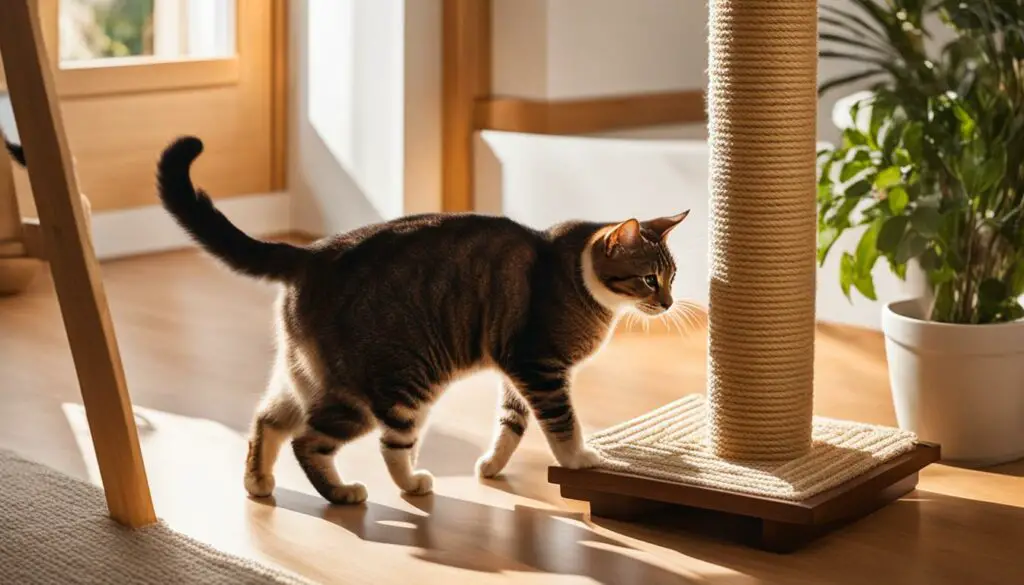
Table: Comparing Positive Reinforcement Techniques
| Technique | Description |
|---|---|
| Treat rewards | Provide small, tasty treats as rewards when your cat uses appropriate scratching surfaces. |
| Praise and attention | Offer verbal praise and extra attention to your cat when they scratch in the desired location. |
| Playtime rewards | Engage in interactive play sessions with your cat as a reward for choosing to scratch in the right place. |
By utilizing positive reinforcement techniques, you can effectively train your cat to stop scratching at doors in the morning. Remember to be patient, consistent, and provide suitable alternatives for your cat’s natural scratching instincts. With time and effort, you can enjoy peaceful mornings without the sound of scratching at your door.
Creating a Safe and Comfortable Sleeping Environment
Cats may scratch at doors in the morning to seek attention or access to the sleeping area. Creating a comfortable and safe sleeping environment for the cat can alleviate the need for scratching. Providing cozy beds or blankets with familiar scents outside the bedroom door can give the cat a designated sleeping area. This can help reduce the desire to scratch at doors and disturb their human companions.
To create a safe and comfortable sleeping environment, consider placing a soft and cozy cat bed near the bedroom door. Choose a bed that is the appropriate size for your cat and filled with plush material for extra comfort. You can also add a familiar piece of clothing or a blanket with your scent to provide a sense of security and familiarity for your cat.
Additionally, ensure that the sleeping area is quiet and free from disturbances. Close doors to other rooms that your cat may try to access during the night, as this can lead to scratching behavior. If outdoor stimulation is a problem, consider blocking your cat’s view of the outside or using curtains to minimize visual stimuli that may entice them to scratch at doors in the morning.
| Sleeping Environment Tips |
|---|
| Create a designated sleeping area with a cozy bed or blanket near the bedroom door. |
| Add familiar scents to the sleeping area, such as a piece of clothing or a blanket with your scent. |
| Ensure a quiet environment by closing doors to other rooms and minimizing outdoor stimulation. |
By providing a safe and comfortable sleeping environment, you can help address the underlying reasons for your cat’s scratching behavior and promote a peaceful morning routine for both you and your feline companion.

Creating a Soothing Atmosphere
In addition to a comfortable sleeping area, consider creating a soothing atmosphere in your home. Playing soft, calming music or using a diffuser with pheromone sprays can help reduce stress and anxiety in cats, which may contribute to door scratching behavior. These simple additions can help create a relaxing environment that encourages your cat to rest and reduces the need for attention-seeking behaviors.
- Play soft, calming music to create a soothing atmosphere.
- Use a diffuser with pheromone sprays to reduce stress and anxiety.
By combining a comfortable sleeping area with a soothing atmosphere, you can help your cat feel secure and content, reducing the urge to scratch at doors in the morning.
Patience and Understanding
When it comes to training cats to stop scratching doors in the morning, patience and understanding are key. Punishment is not an effective method as it can create fear and stress in cats, leading to further behavior issues. Instead, I recommend using positive reinforcement techniques to redirect their behavior.
One effective method is to provide alternative scratching surfaces such as scratching posts or boards. Cats naturally scratch to mark territory and maintain their claws, so offering appropriate outlets for this behavior can help redirect their scratching away from doors. Additionally, providing environmental enrichment, such as interactive toys and mental stimulation, can keep them engaged and reduce the desire to scratch at doors in the morning.
Consistency is also important in training cats. By consistently using positive reinforcement and offering praise, treats, or playtime when they use appropriate scratching surfaces, you can reinforce the desired behavior. It’s important to understand that changing a cat’s behavior takes time, so patience is key.
| Effective Methods to Stop Cat Scratching at Doors |
|---|
| Provide alternative scratching surfaces |
| Offer environmental enrichment and mental stimulation |
| Consistently use positive reinforcement |
Remember, it’s crucial to approach the training process with empathy and without resorting to punishment. By incorporating patience, understanding, and effective strategies, you can successfully train your cat to stop scratching doors in the morning and enjoy peaceful mornings together.
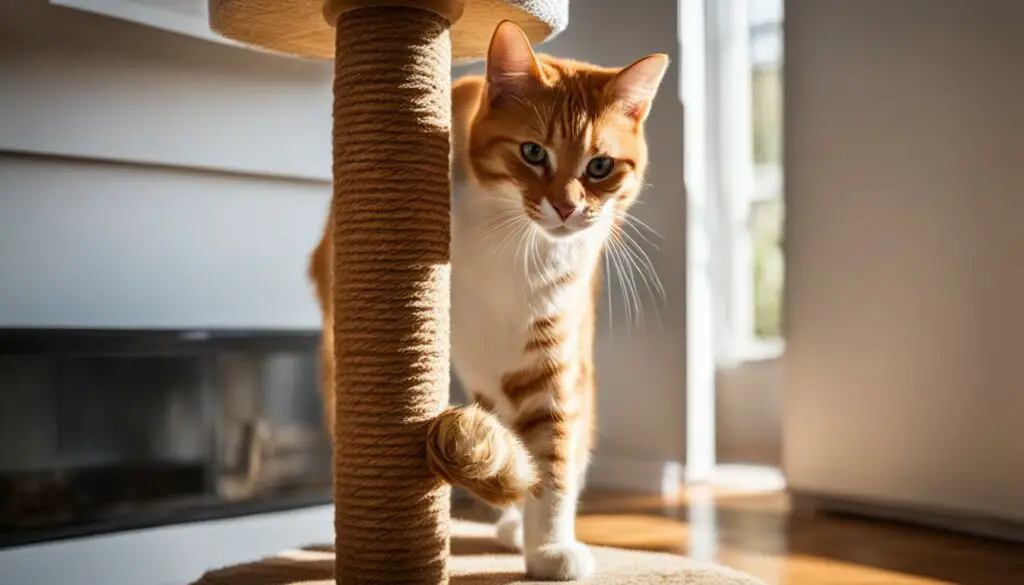
Seeking Veterinary Advice
If your cat’s scratching behavior persists or is accompanied by other concerning symptoms, it is advisable to consult a veterinarian. Cats scratching at doors in the morning may be a sign of underlying medical conditions or discomfort. Seeking veterinary advice will help determine if there are any health issues contributing to the behavior and provide appropriate guidance for prevention and management. It is essential to address any possible pain, infection, or hormonal imbalances that could be causing the cat’s scratching behavior.
Preventing door scratching in cats is crucial for both the cat’s well-being and maintaining a peaceful home environment. A veterinarian can conduct a thorough examination and run necessary tests to diagnose any medical conditions. They may recommend treatments, medications, or dietary changes to address the underlying cause of the scratching behavior. Additionally, they can provide guidance on behavior modification techniques and recommend specific products or environmental modifications that may help discourage door scratching.
When seeking veterinary advice, be prepared to provide detailed information about your cat’s behavior, including when the scratching occurs, the duration and intensity of the behavior, and any other accompanying signs or symptoms. It is also helpful to document any changes in the cat’s environment or routine that may have coincided with the onset of the scratching behavior.
| Signs to look out for: | Possible medical causes: |
|---|---|
| Excessive scratching at doors | Arthritis |
| Changes in appetite or weight | Hyperthyroidism |
| Behavioral changes | Urinary tract infection |
| Increased vocalization | Skin allergies or infections |
Remember, every cat is unique, and their scratching behavior may have different underlying causes. Seeking veterinary advice ensures that your cat’s individual needs are addressed, leading to effective prevention strategies and a happier, healthier feline companion.

Conclusion
In conclusion, stopping a cat from scratching at doors in the morning requires understanding their behavior and providing suitable alternatives. Punishment is not effective and can even worsen the problem. Instead, positive reinforcement techniques and the use of deterrents can be successful in modifying the behavior.
Creating a routine with interactive playtime and feeding before bedtime can help tire out cats and promote relaxation during the night. Offering scratching posts and providing a variety of toys can redirect their scratching behavior. Consistency and persistence are key in reinforcing positive behavior and discouraging scratching at doors.
If the problem persists, seeking professional help from a cat behaviorist or veterinarian is advisable. They can provide personalized advice and techniques based on the specific needs of the cat. Understanding and addressing a cat’s natural behavior is crucial for finding effective solutions.
With patience, understanding, and the implementation of effective strategies, it is possible to prevent cats from scratching at doors in the morning and enjoy peaceful mornings with our feline companions.
FAQ
Why does my cat scratch at doors in the morning?
Cats may scratch at doors in the morning as a way to seek attention or food, or it could be a sign of boredom or a desire for social interaction.
Is punishment an effective way to deter my cat from scratching at doors?
No, punishment is not an effective method to deter this behavior. It can create negative associations and escalate the problem.
What can I do to discourage my cat from scratching doors in the morning?
Providing alternatives such as scratching posts, environmental enrichment, and playtime can be more successful in modifying behavior. Sticky tape, deterrent sprays, and aluminum foil can also be used to discourage scratching.
How can I train my cat to stop scratching at doors?
It is important to use positive reinforcement and provide suitable alternatives. Rewarding desired behavior with praise, treats, or playtime can motivate cats to repeat those behaviors.
What should I do if my cat’s scratching behavior persists?
If the scratching behavior continues despite efforts to modify it, seeking guidance from a professional cat behaviorist or veterinarian may be beneficial.
Why do cats scratch in general?
Cats scratch for various reasons, including marking territory, stretching, and maintaining healthy claws.
How can I prevent my cat from scratching at doors?
Providing appropriate scratching surfaces, such as vertical and horizontal scratching posts, and removing potential triggers can help redirect their scratching behavior away from doors.
How long does it take to change a cat’s scratching behavior?
Changing a cat’s behavior takes time and consistency. It is important to be persistent in implementing deterrents, providing alternatives, and reinforcing positive behavior.
How can I create a comfortable sleeping environment for my cat?
Providing cozy beds or blankets with familiar scents outside the bedroom door can give the cat a designated sleeping area and reduce the desire to scratch at doors.
Is it advisable to seek professional help for cat scratching behavior?
If the scratching behavior persists or is accompanied by other concerning symptoms, it is recommended to consult a veterinarian or professional cat behaviorist for personalized advice and guidance.
Why is positive reinforcement important in training cats?
Positive reinforcement is essential in training cats as it rewards desired behaviors and motivates them to repeat those behaviors in the future.
Are there any medical conditions that can contribute to scratching behavior?
Yes, medical issues such as pain, infection, or hyperthyroidism can contribute to changes in behavior patterns. Seeking veterinary advice can help rule out any underlying medical conditions.








